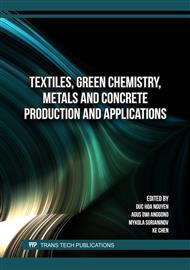p.29
p.39
p.49
p.55
p.63
p.71
p.79
p.87
p.95
Dyeability of Cotton Fabric with Extract from Bougainvillea Glabra
Abstract:
In this study, cotton fabrics were dyed with extracts from Bougainvillea glabra (BG) flowers which are widely grown around the world, especially in Southeast Asia. The obtained results indicated the dyeability of dyed fabrics were influenced by BG concentration, exhaustion temperature, dyeing time, types and content of mordants, and the amount of alkali in the washing solution. By comparing color difference (DE) between standard sample and dyed sample, it is confirmed that dyeing efficiency was significantly improved with increased BG concentration and exhaustion temperature. All cotton fabrics should be dyed with BG extracts at reasonable temperature, ideally below 45°C. While the presence of metal mordants such as FeSO4.7H2O, CuSO4.5H2O and KAl(SO4)2.12H2O increased the color fastness of the dyed fabric, they also caused seriously color change as compared to fabric dyed without mordants. To ensure color fastness during washing, dyed samples with BG extracts should be laundered with low alkalinity solution.
Info:
Periodical:
Pages:
63-69
Citation:
Online since:
December 2024
Authors:
Price:
Сopyright:
© 2024 Trans Tech Publications Ltd. All Rights Reserved
Share:
Citation:



